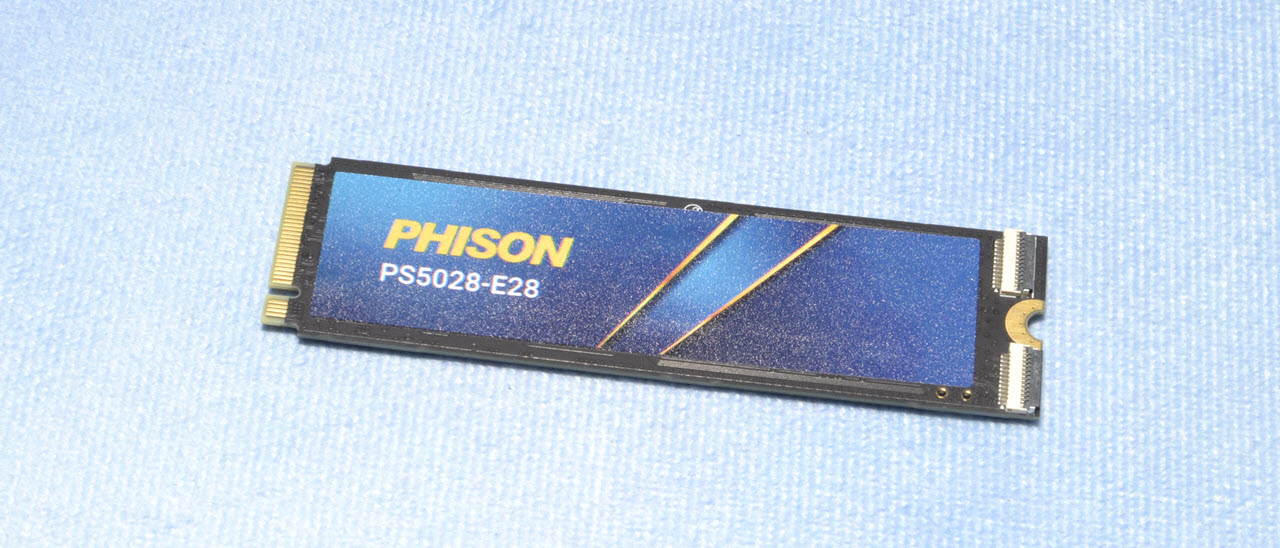Why you can trust Tom's Hardware
Trace Testing — 3DMark Storage benchmark
Built for gamers, 3DMark’s Storage Benchmark focuses on real-world gaming performance. Each round in this benchmark stresses storage based on gaming activities including loading games, saving progress, installing game files, and recording gameplay video streams. Future gaming benchmarks will be DirectStorage-inclusive and we also include notes about which drives may be future-proofed.
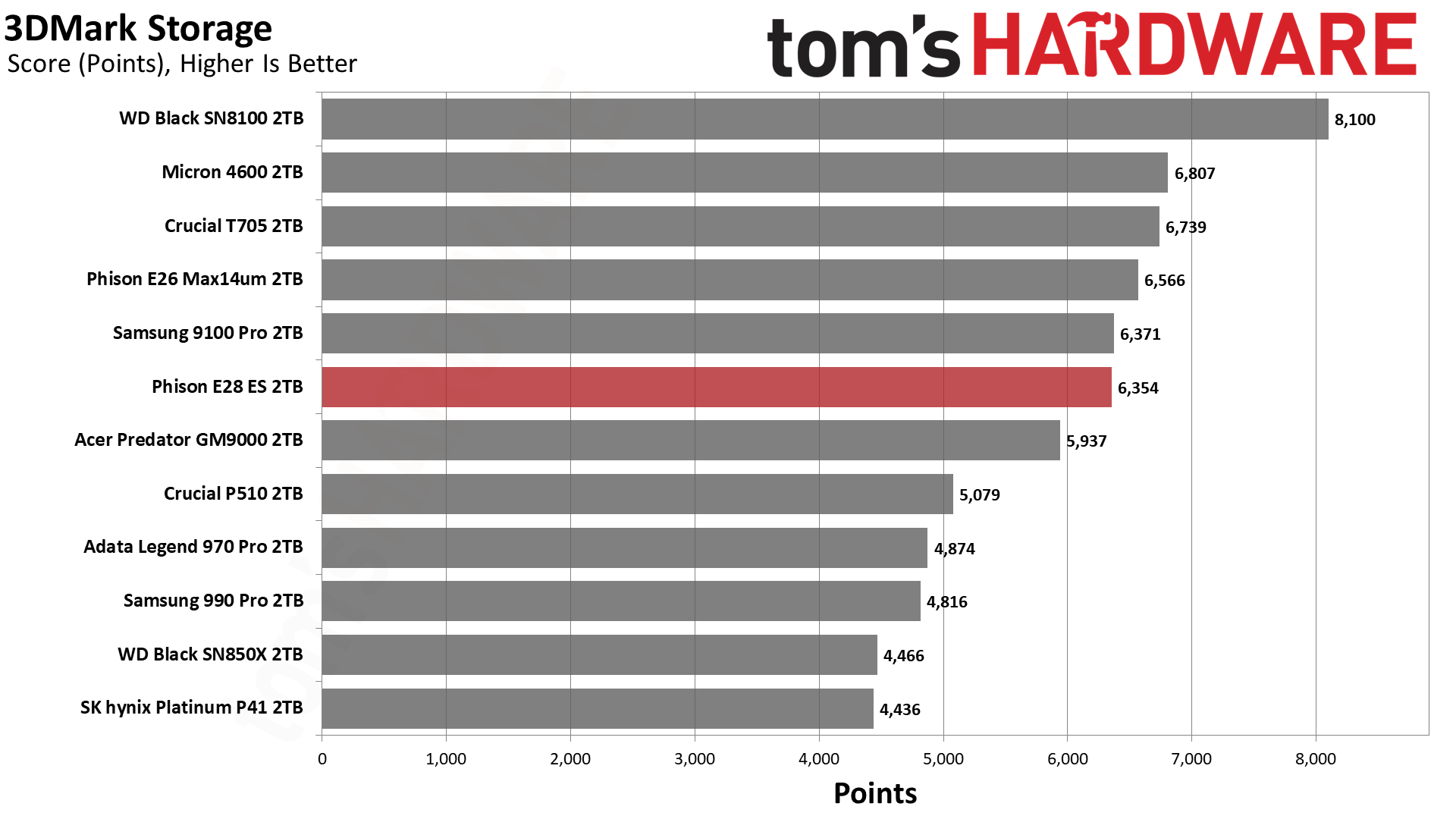
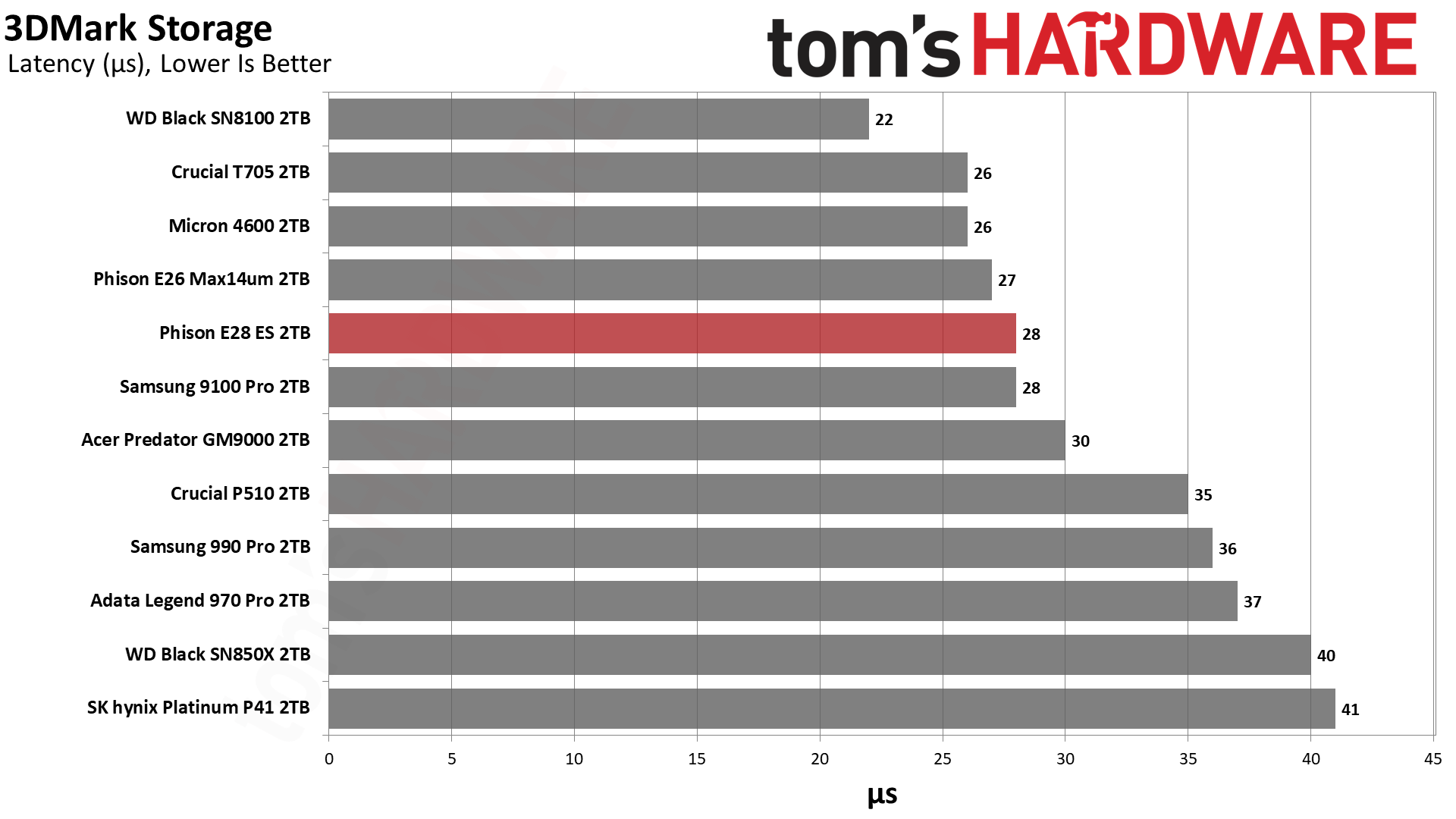

The Phison E28 sets no records in 3DMark, but the results are good. It matches up well with the Samsung 9100 Pro and the Phison E26 as well, for that matter. We expect that this controller will have Phison’s I/O+ firmware for when DirectStorage finally starts to take off. The results here are therefore not too concerning as all of these drives are overkill for gaming, at least as the situation currently stands.
Trace Testing — PCMark 10 storage benchmark
PCMark 10 is a trace-based benchmark that uses a wide-ranging set of real-world traces from popular applications and everyday tasks to measure the performance of storage devices. The results are particularly useful when analyzing drives for their use as primary/boot storage devices and in work environments.
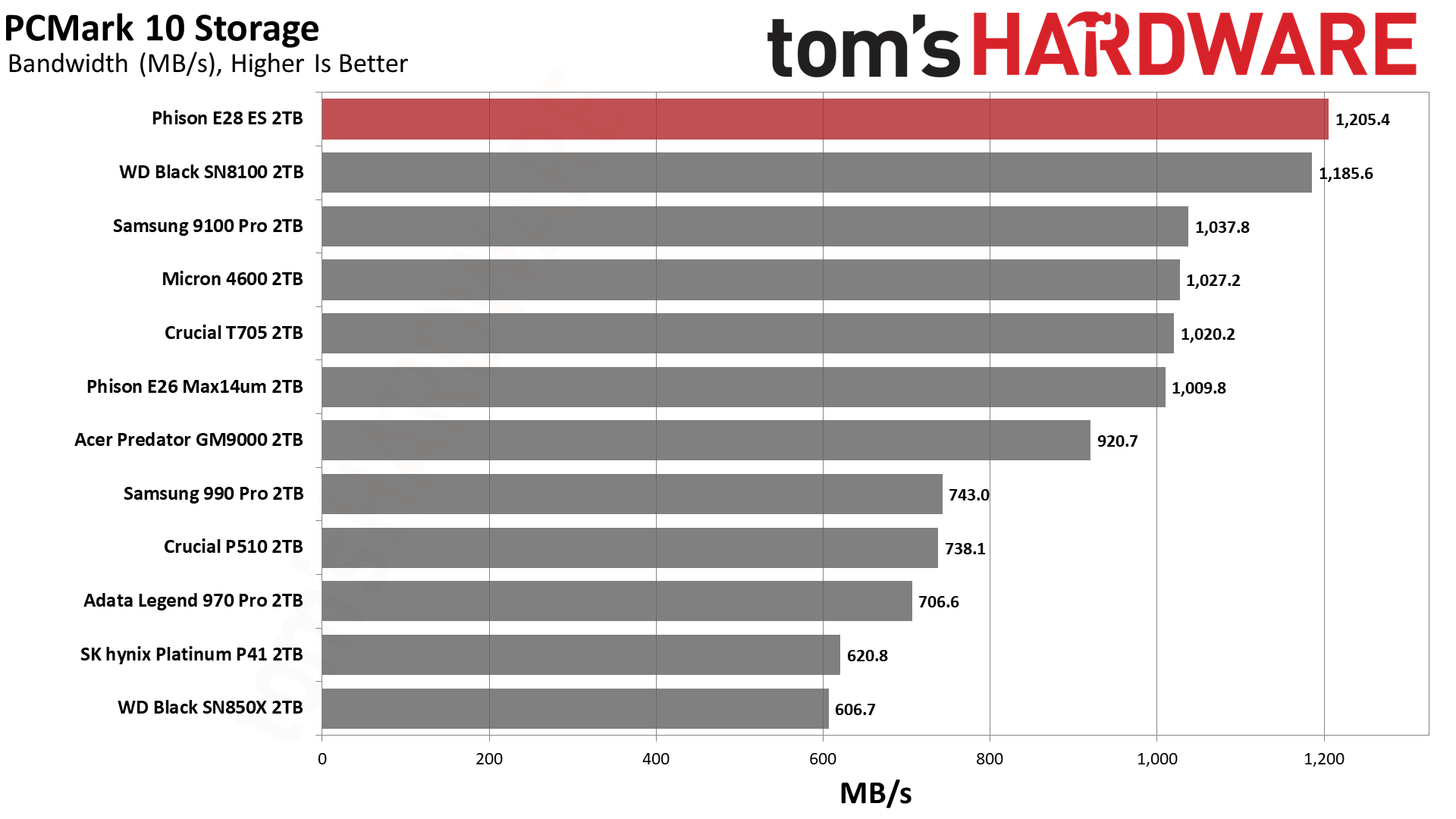
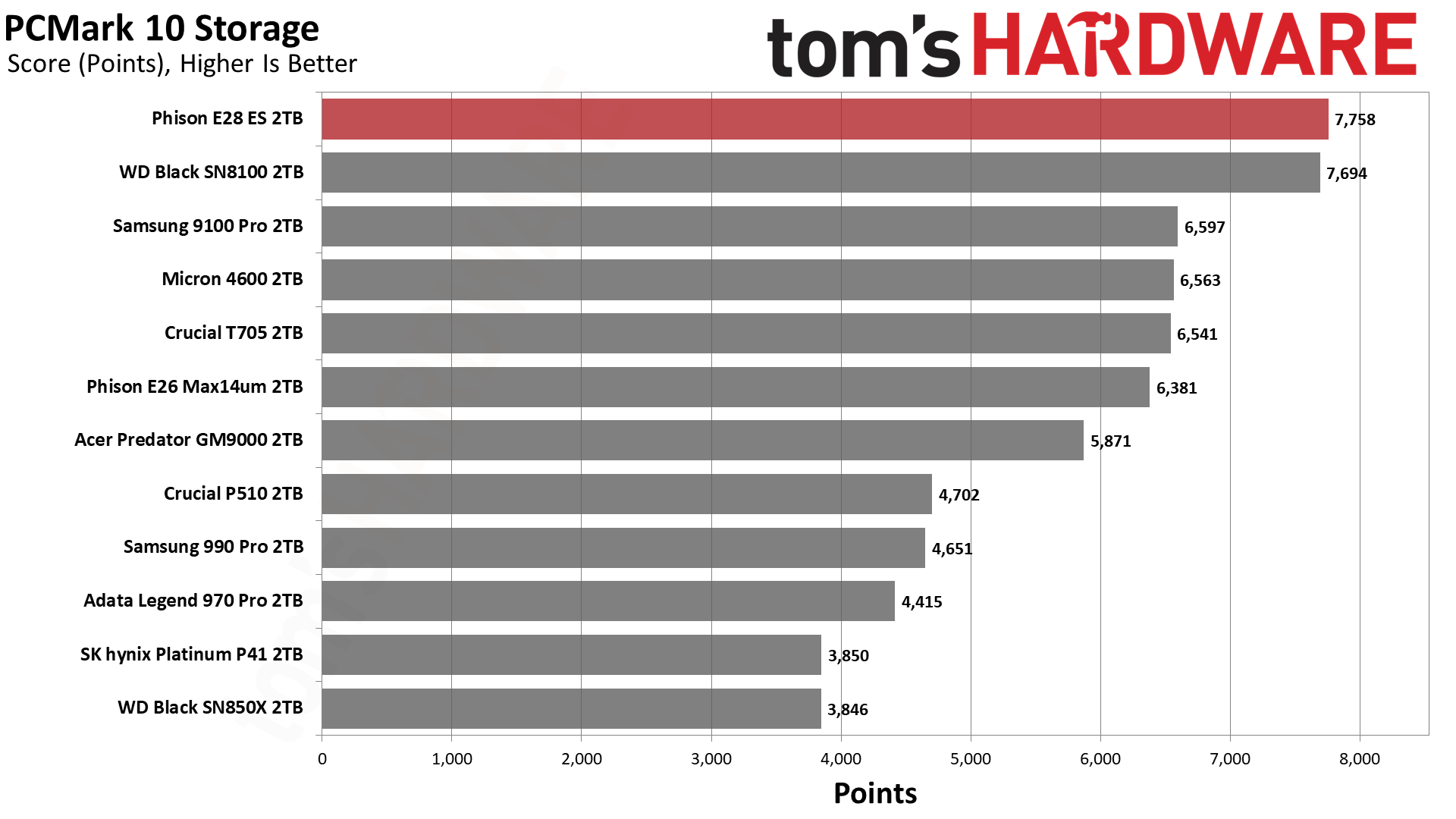
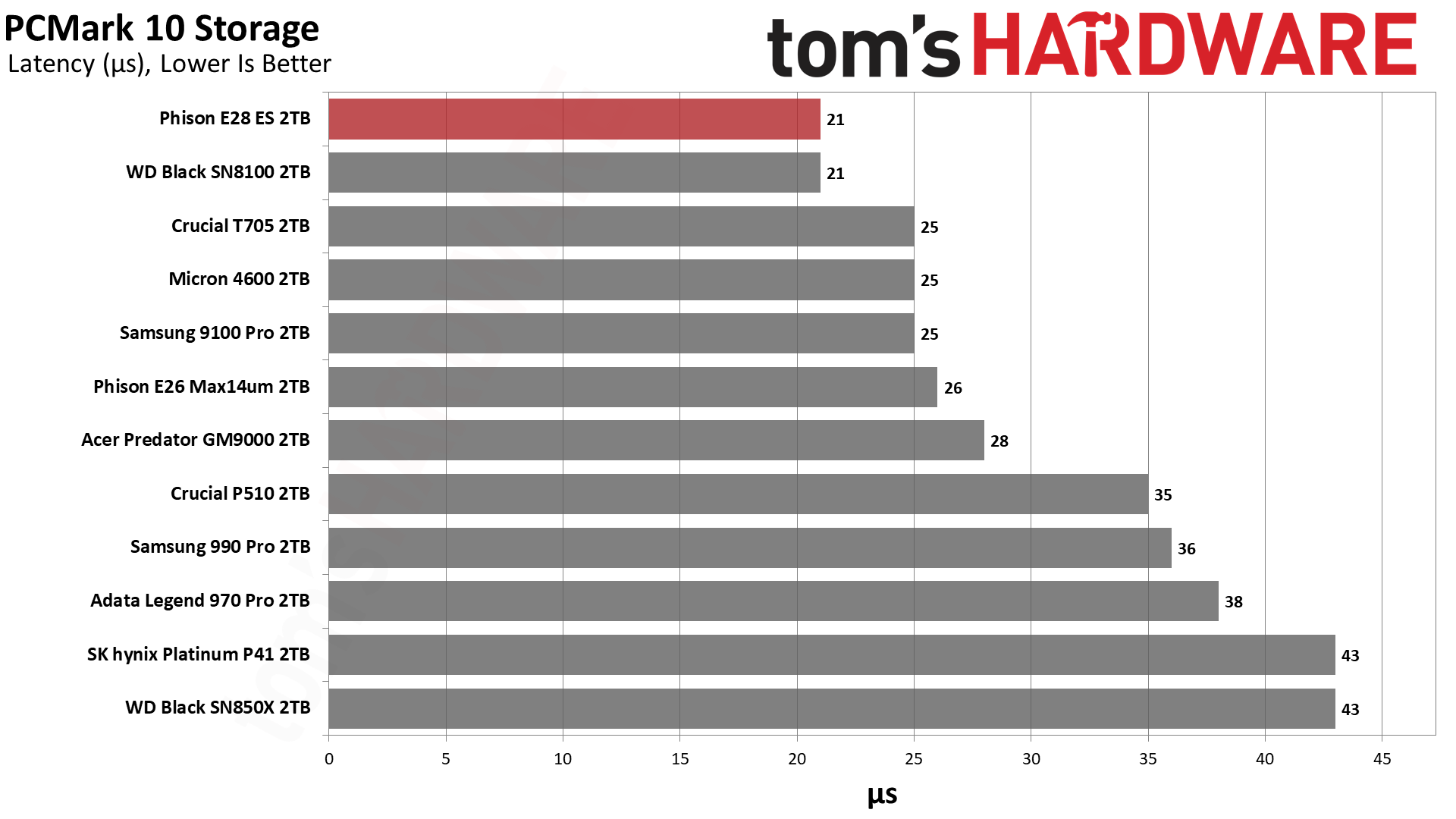
PCMark 10, on the other hand, is where the E28 shines. Performance here is a resounding success, bringing in the best results we’ve ever seen. It doesn’t edge the WD Black SN8100 by much, but winning’s winning. The E28 can deliver exceptional application performance and it really shows off what a full-fledged PCIe 5.0 SSD can achieve.
Console Testing — PlayStation 5 transfers
The PlayStation 5 is capable of taking one additional PCIe 4.0 or faster SSD for extra game storage. While any 4.0 drive will technically work, Sony recommends drives that can deliver at least 5,500 MB/s of sequential read bandwidth for optimal performance. In our testing, PCIe 5.0 SSDs don’t bring much to the table and generally shouldn’t be used in the PS5, especially as they may require additional cooling. Check our Best PS5 SSDs article for more information.
Our testing utilizes the PS5’s internal storage test and manual read/write tests with over 192GB of data both from and to the internal storage. Throttling is prevented where possible to see how each drive operates under ideal conditions. While game load times should not deviate much from drive to drive, our results can indicate which drives may be more responsive in long-term use.

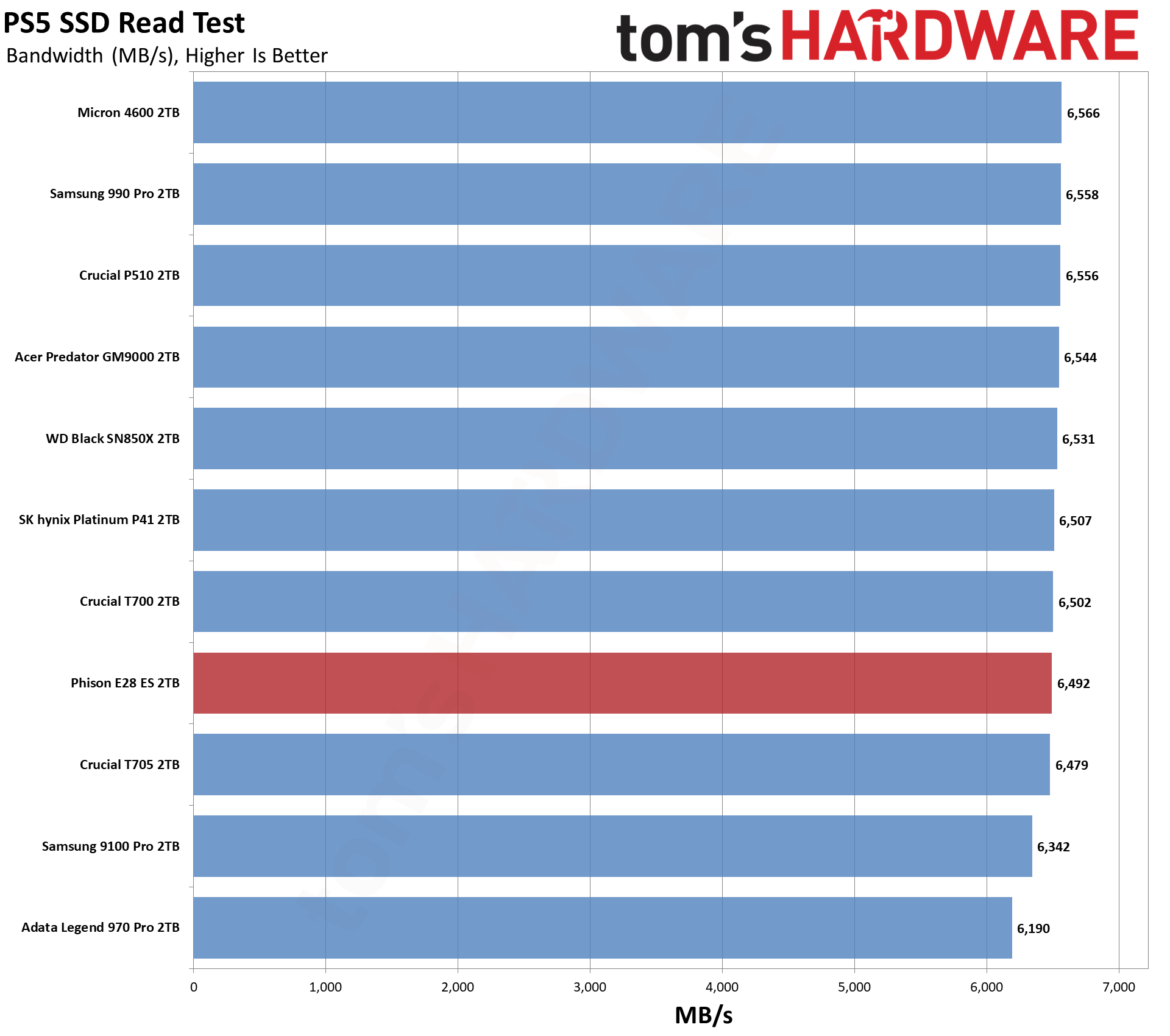
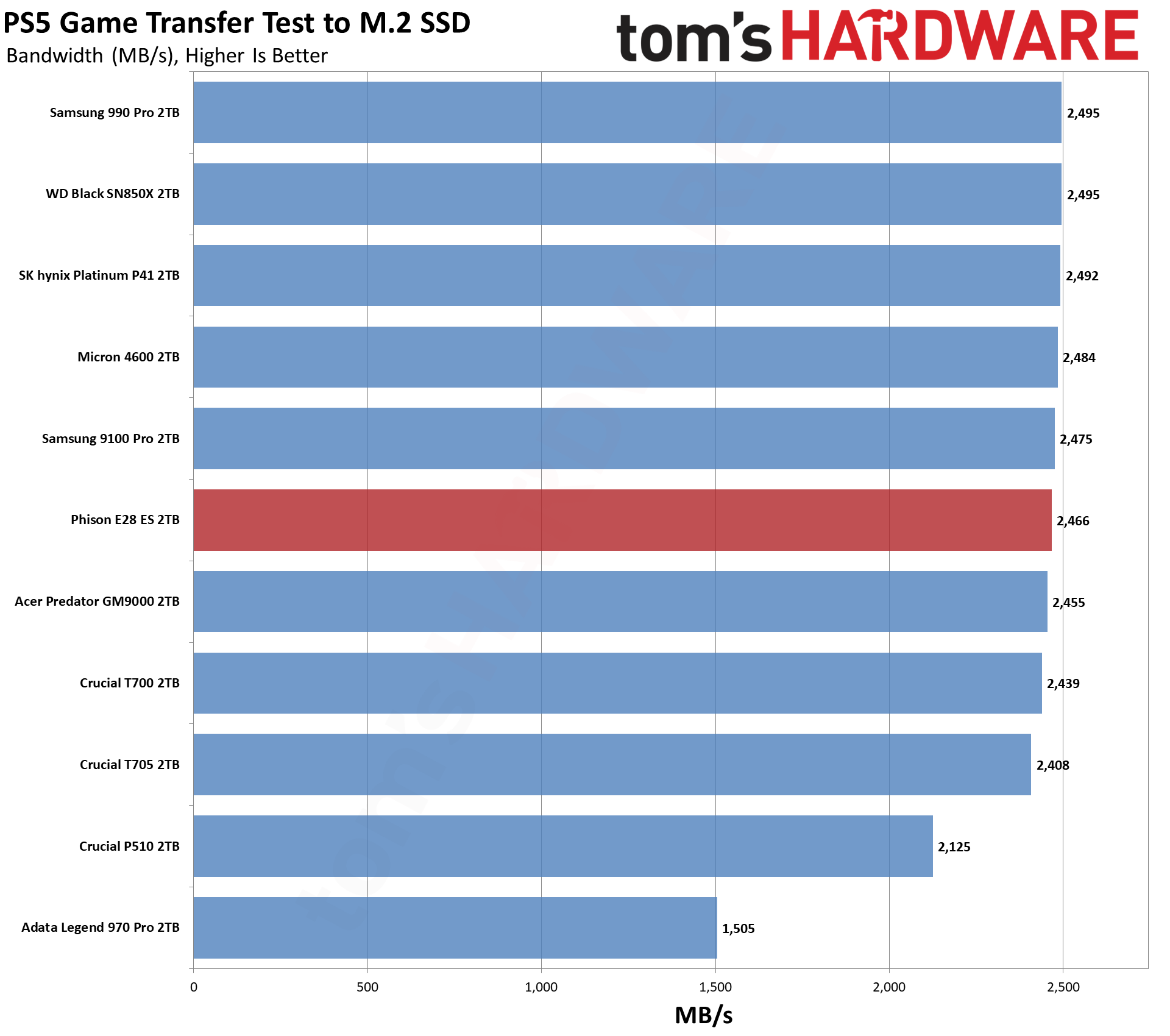
We don’t recommend using a high-end SSD for the PlayStation 5, especially a high-end Gen 5 SSD, but the E28 will work just fine if you decide to go that way.
Get Tom's Hardware's best news and in-depth reviews, straight to your inbox.
Transfer rates — DiskBench
We use the DiskBench storage benchmarking tool to test file transfer performance with a custom, 50GB dataset. We write 31,227 files of various types, such as pictures, PDFs, and videos to the test drive, then make a copy of that data to a new folder, and follow up with a reading test of a newly-written 6.5GB zip file. This is a real world type workload that fits into the cache of most drives.
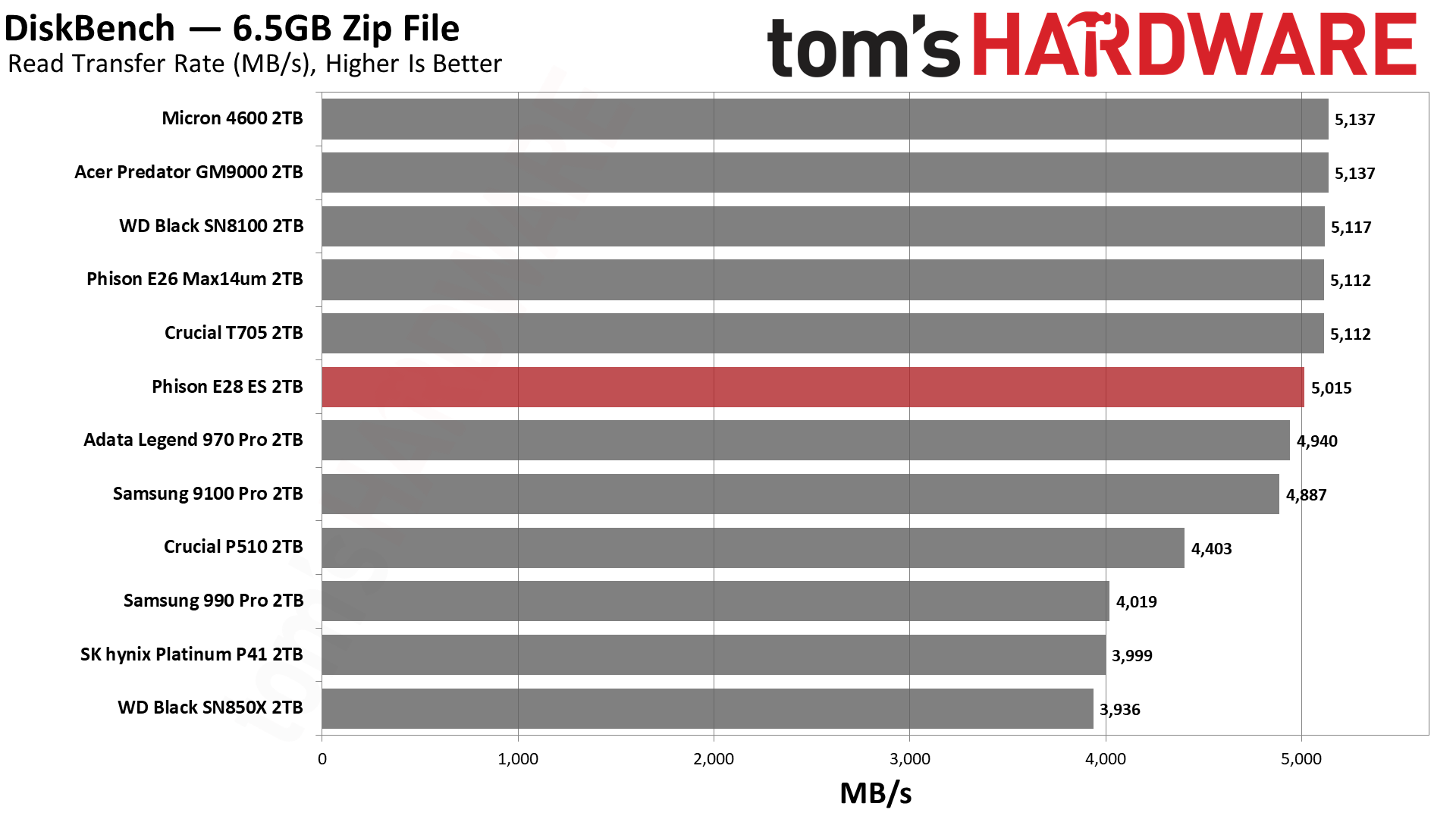


The E28 promises exceptional bandwidth and that’s best represented by our copy test in DiskBench. Here the E28 sets a new record, beating both the SN8100 and E26 by a significant amount. If you want the very best transfer performance, the E28 seems to be the way to go. It will be hard to beat a 6nm, eight-channel controller with DRAM, considering that this setup only needs to run at 2,400 MT/s to essentially maximize the interface throughput.
That said, future controllers could be more efficient – with fewer channels using faster flash and by going DRAM-less – and may also bring higher capacities. Latency could also improve to some extent. Tha's all to say, if you want a ridiculously fast SSD today – with PCIe 6.0 solutions being maybe five years away – the E28 more than fits the bill, but some small improvements here and there remain possible down the road.
Synthetic testing — ATTO / CrystalDiskMark
ATTO and CrystalDiskMark (CDM) are free and easy-to-use storage benchmarking tools that SSD vendors commonly use to assign performance specifications to their products. Both of these tools give us insight into how each device handles different file sizes and at different queue depths for both sequential and random workloads.
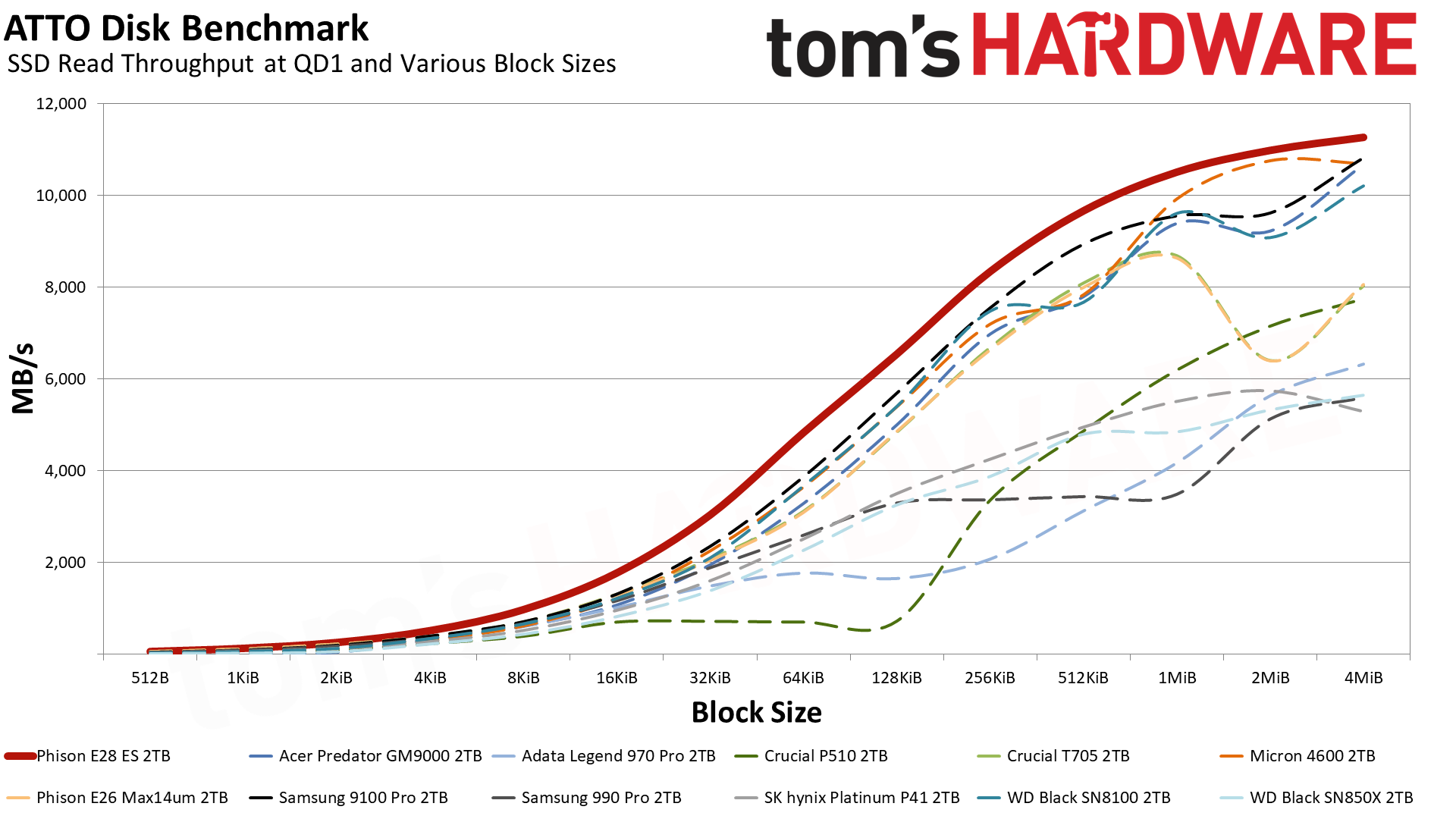
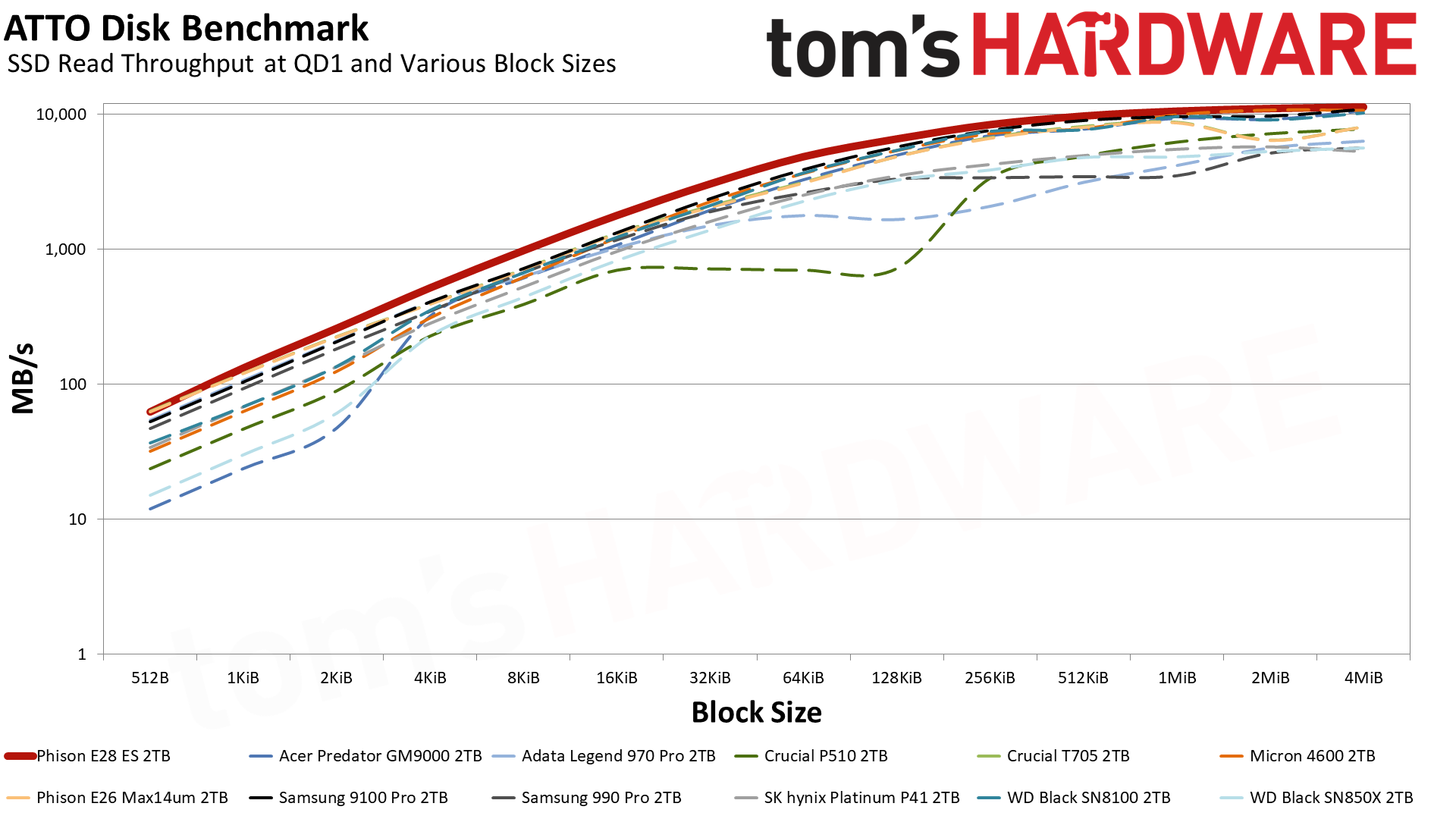
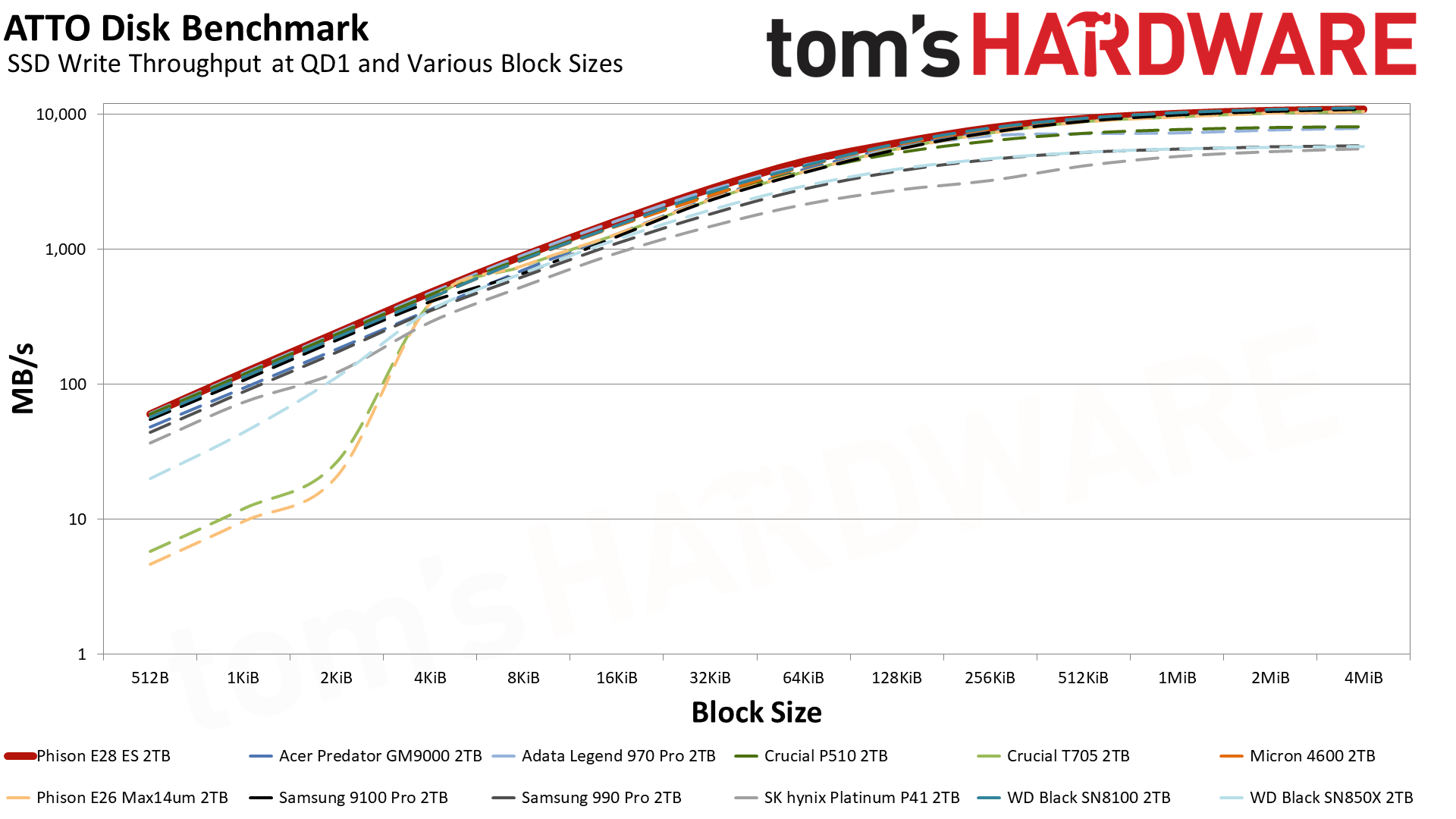

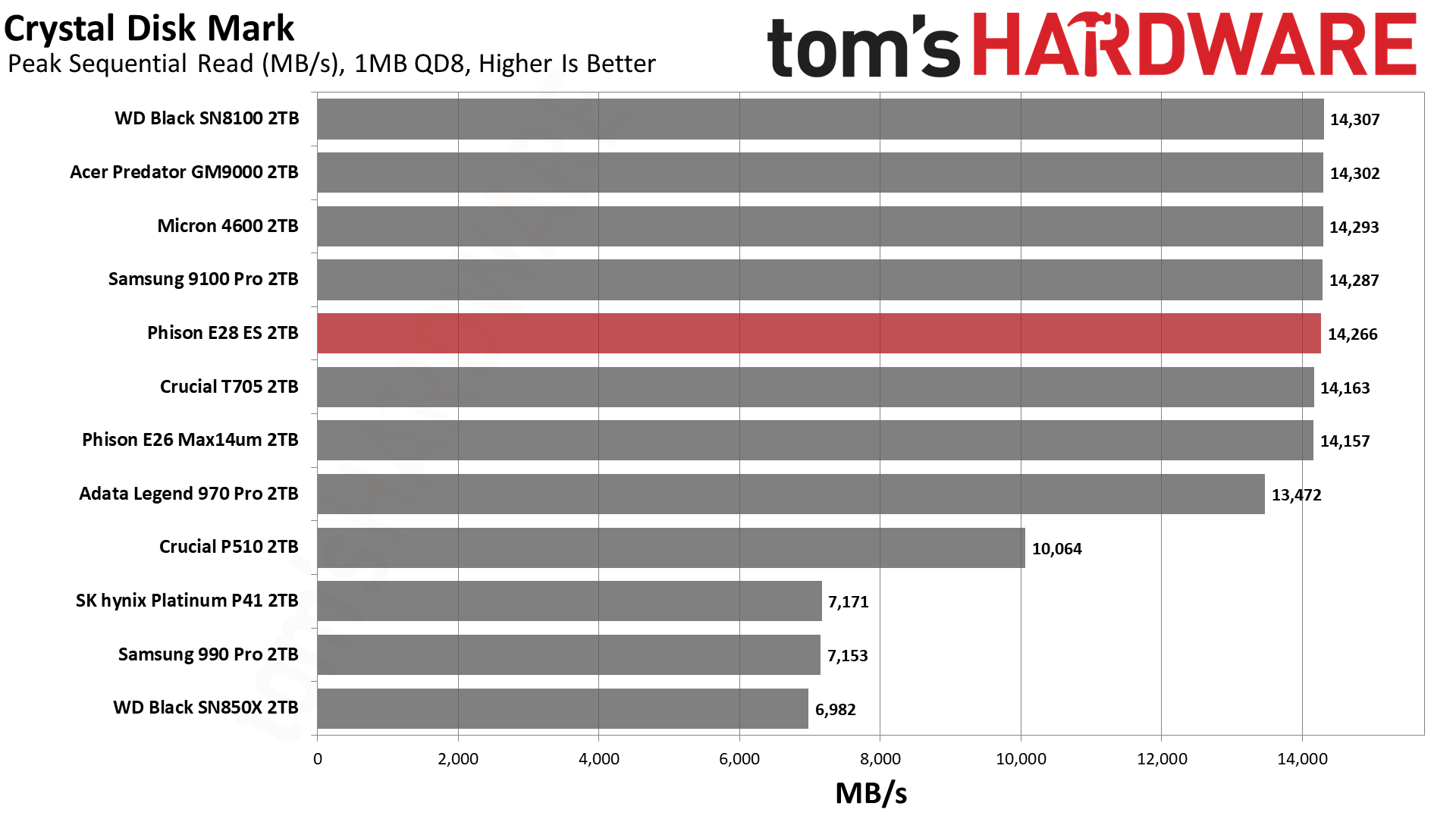
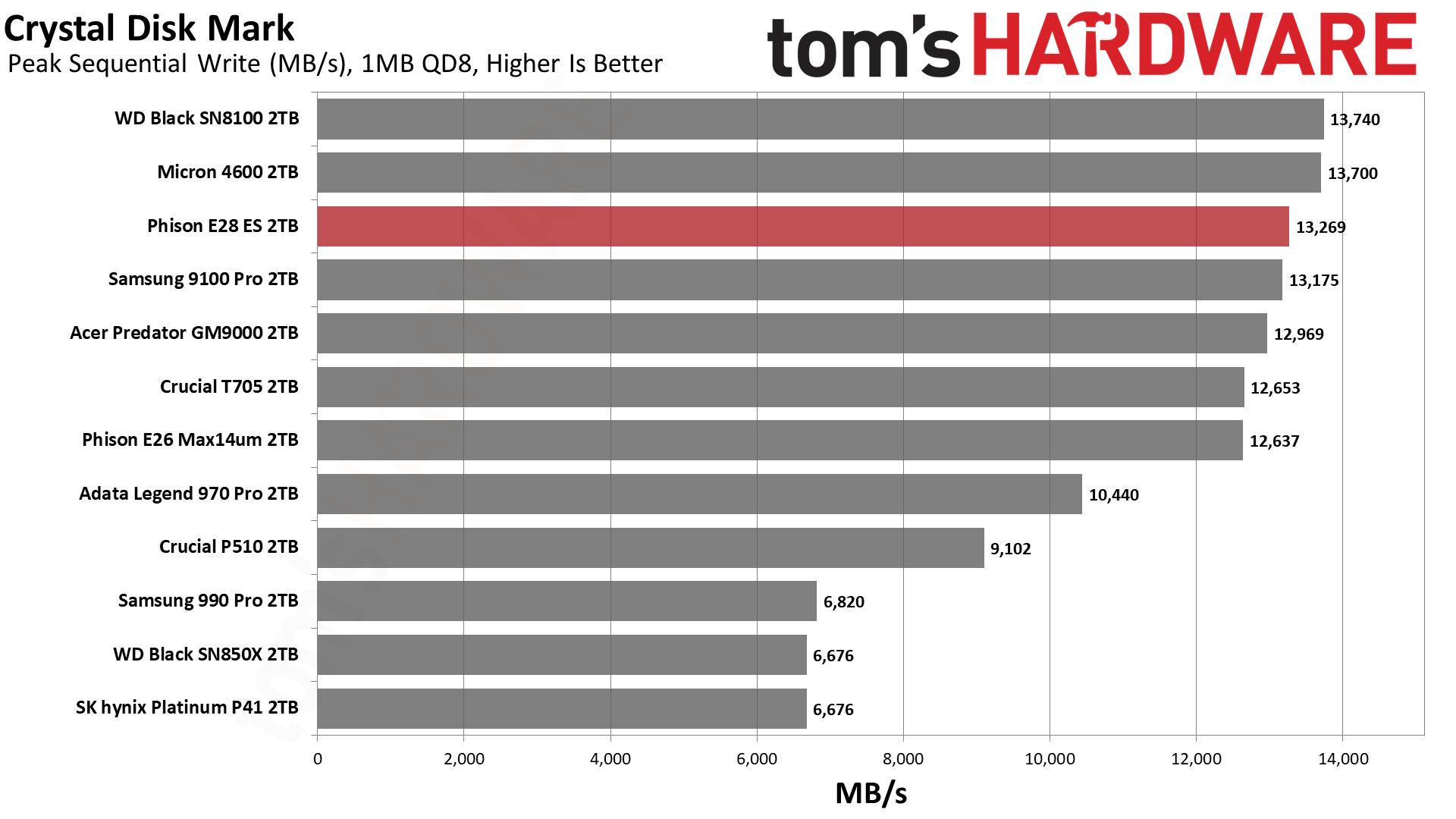
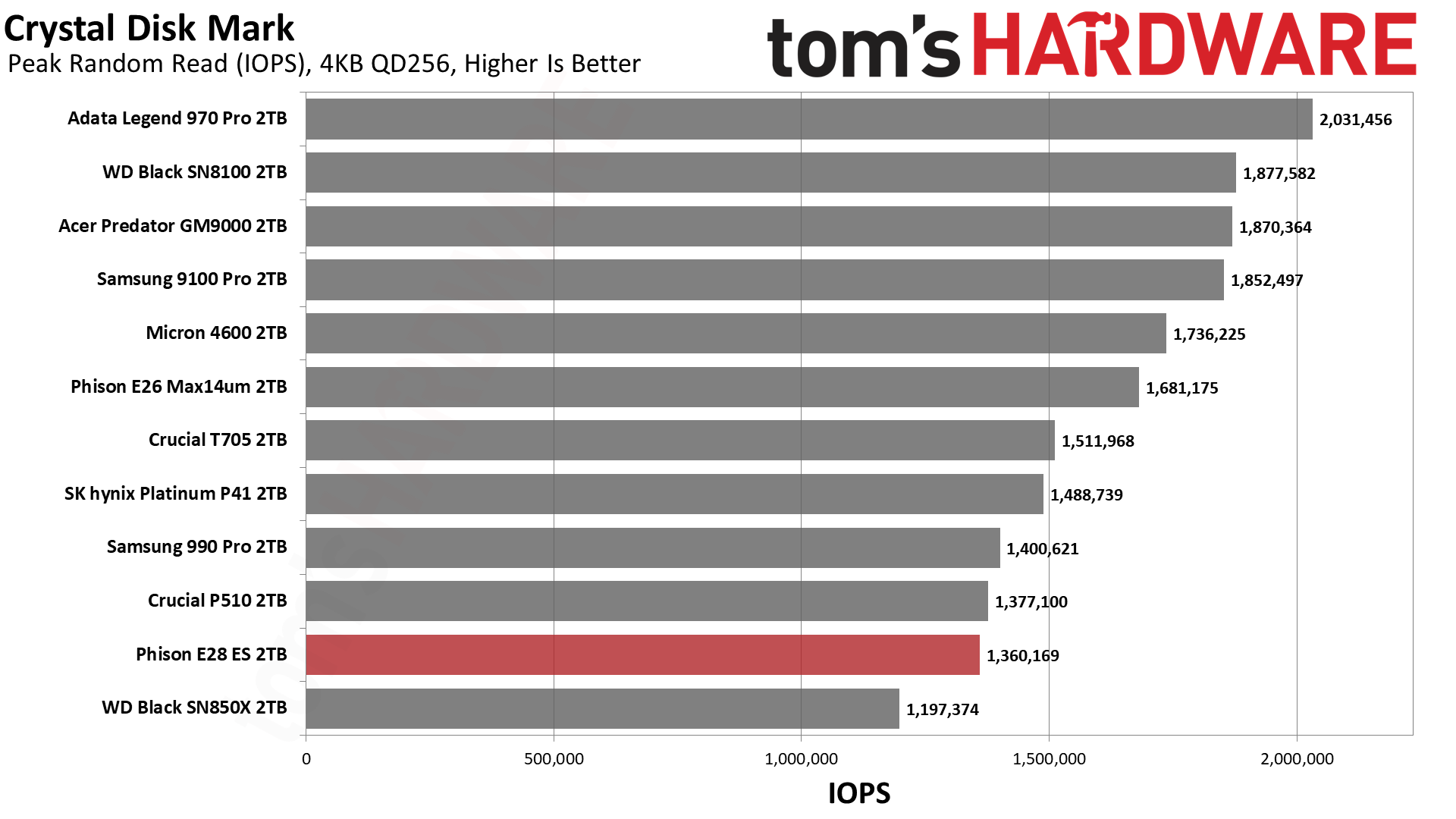


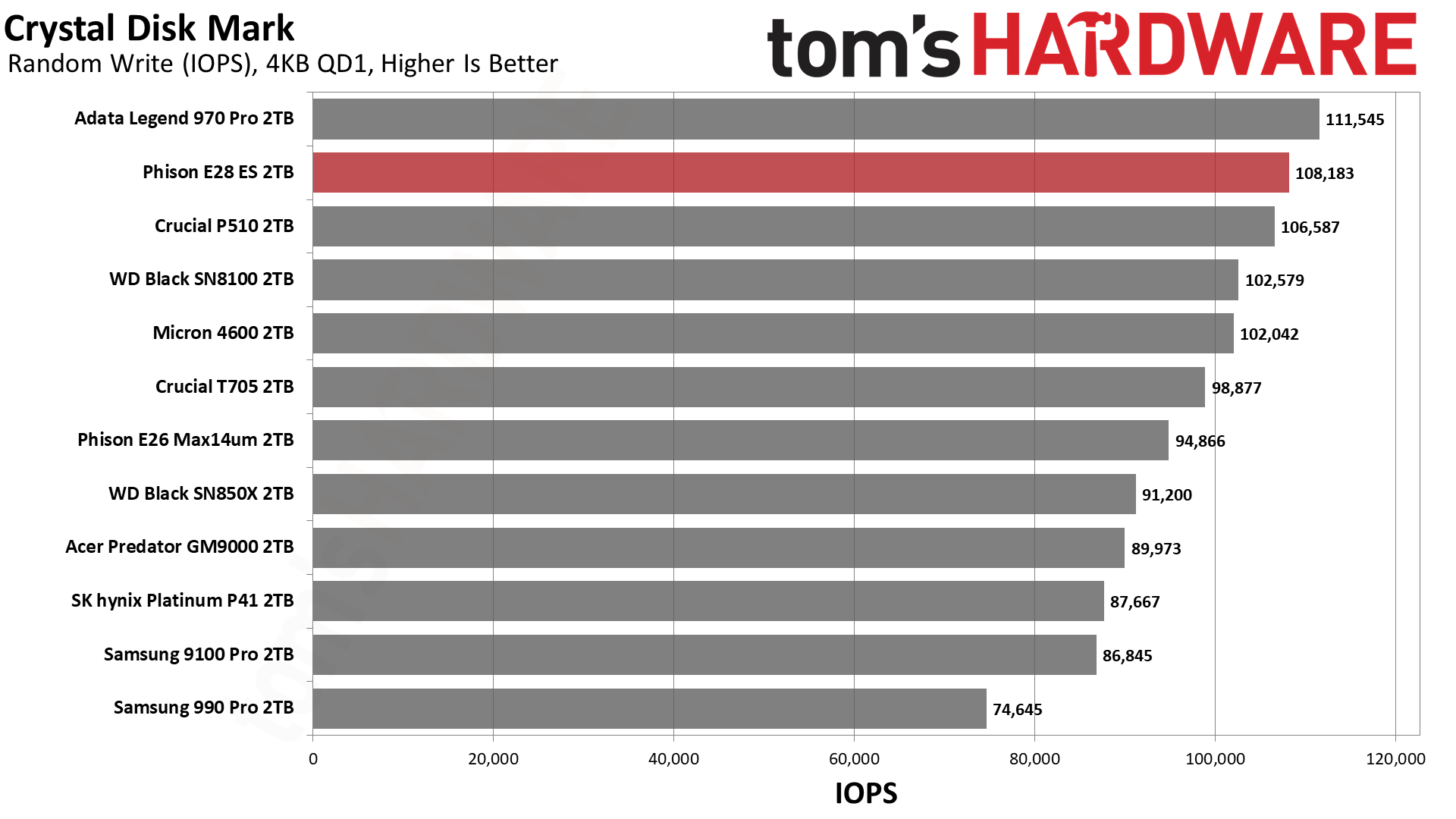
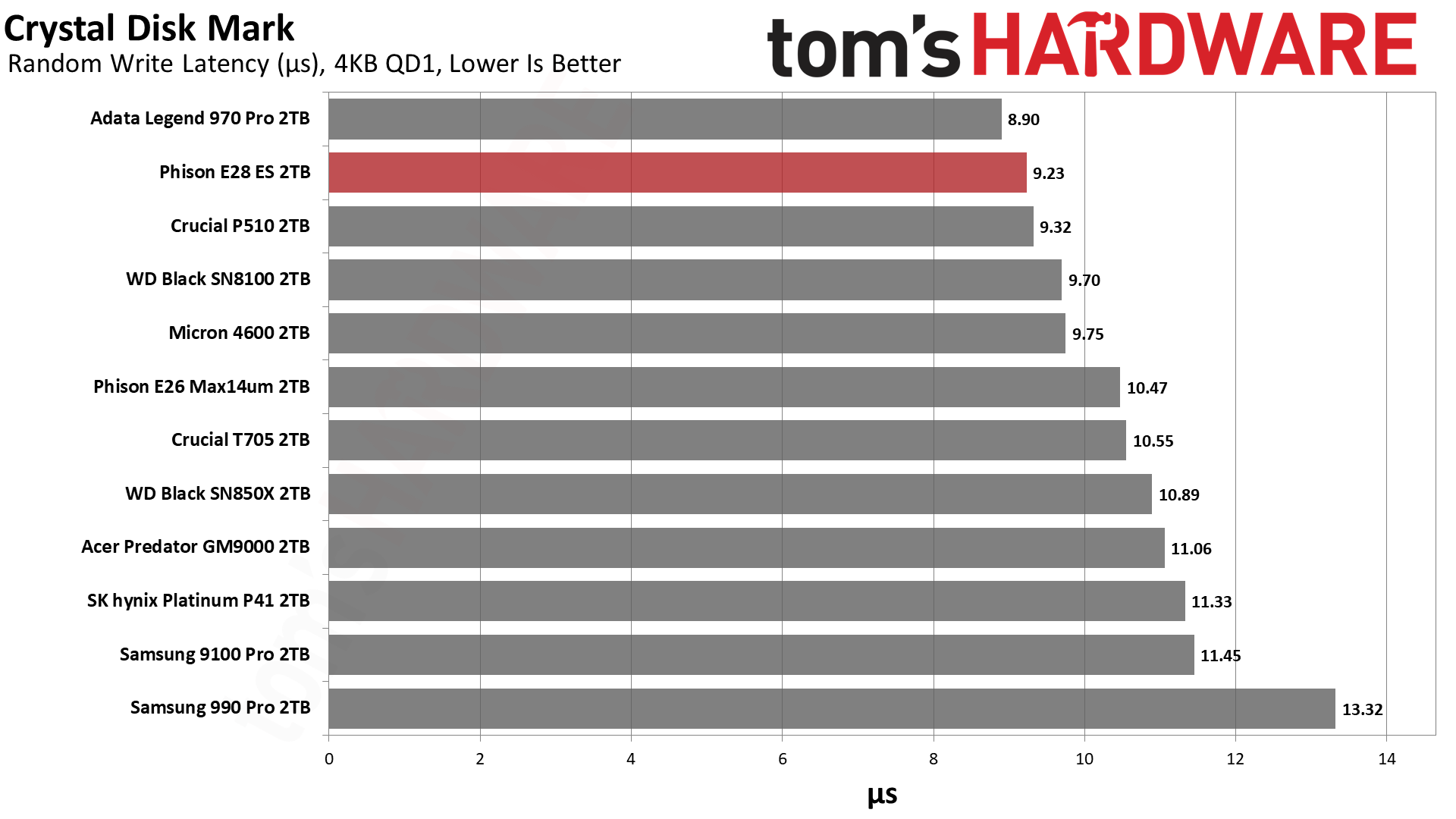
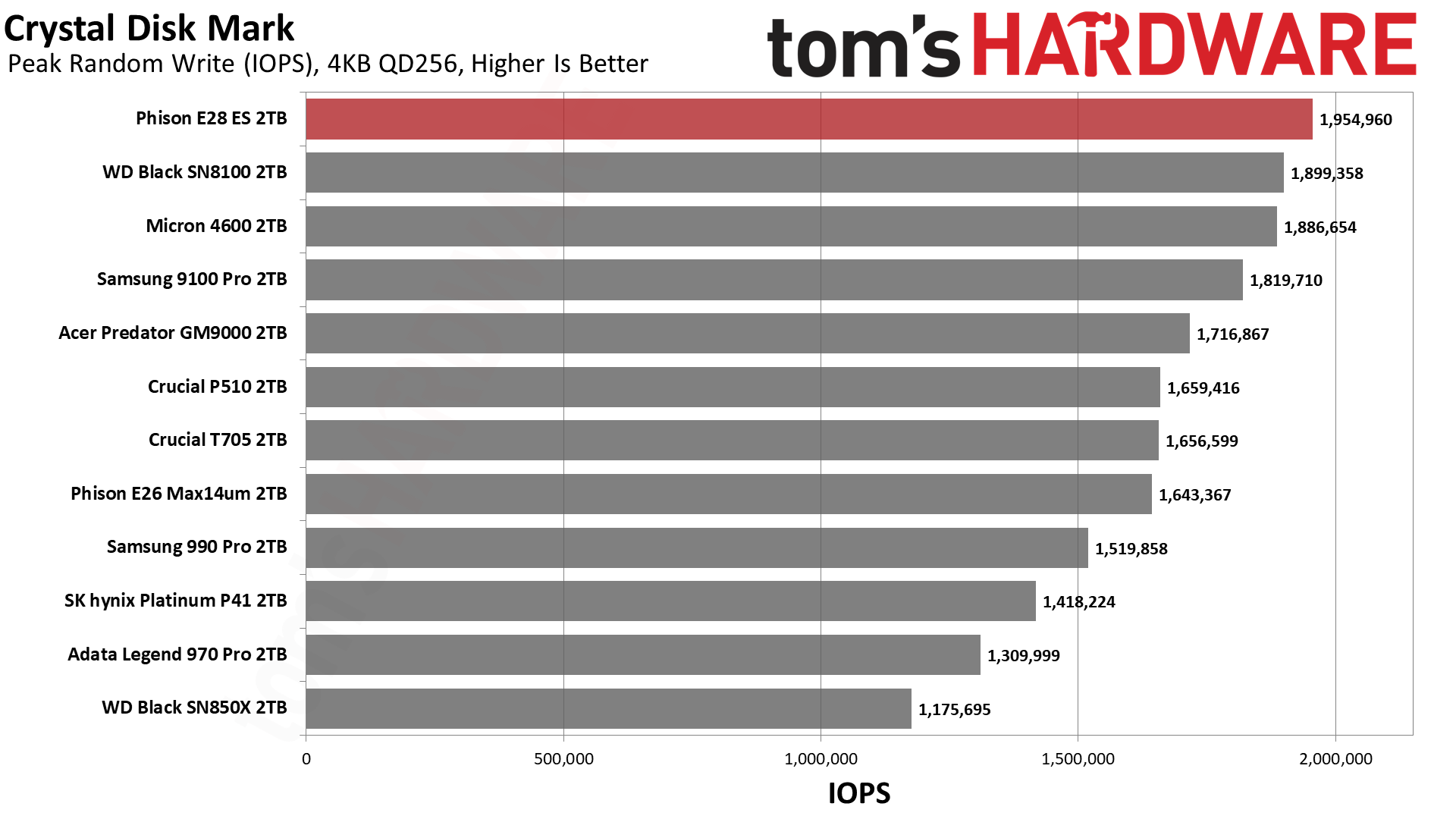

The E28’s ATTO curves are smooth as silk, a nice change from the sometimes bumpy results we see from Phison’s controllers. SMI’s SM2508 – used on the 4600 and WD Black SN8100 – can reach a little higher with writes at larger block sizes, regardless of the flash being used. However, the E28 has a higher read curve, which is probably more desirable for a consumer drive and its applications.
This is reflected in the CDM sequential results, with the E28 easily taking the lead with QD1 reads, with a small amount of trailing for QD1 writes. When a higher QD is factored in, the E28 reaches the limits of the interface for reads but remains behind on writes. Most consumer operations will be at a low queue depth and, in particular, file transfers might only be QD1, so being able to pull large files the fastest off an E28 drive is a point in its favor.
Random performance, which is what many people prefer to look at, is a different story. The excellent random read latency we expect from BiCS8 remains on the E28, but the drive is not as well-optimized as the WD Black SN8100 and its SM2508 controller. Phison has suggested this will be improved in time for the retail launch. Random write performance, on the other hand, favors the E28. We think in most cases you won’t see a real difference here – the bottleneck will lie elsewhere – but it’s still good to see the very good numbers the E28 puts up. If there’s a weak point here, it’s that the E28’s peak random read IOPS are on the low side, but this will probably be ameliorated by the time of retail launch.
Sustained write performance and cache recovery
Official write specifications are only part of the performance picture. Most SSDs implement a write cache, which is a fast area of pseudo-SLC (single-bit) programmed flash that absorbs incoming data. Sustained write speeds can suffer tremendously once the workload spills outside of the cache and into the "native" TLC (three-bit) or QLC (four-bit) flash. Performance can suffer even more if the drive is forced to fold, which is the process of migrating data out of the cache in order to free up space for further incoming data.
We use Iometer to hammer the SSD with sequential writes for 15 minutes to measure both the size of the write cache and performance after the cache is saturated. We also monitor cache recovery via multiple idle rounds. This process shows the performance of the drive in various states as well as the steady state write performance.



The E28 writes in its fastest, single-bit cache mode at 13 GB/s for almost 18 seconds. The cache is around 228GB, which is on the smallish size for a 2TB drive but absolutely sufficient. The drive then hits a TLC mode where it can write at around 2.77 GB/s. This is maintained for a long time before it hits a recovery folding state that oscillates between being bottlenecked and using freed up flash for a sustained rate around 2.74 GB/s. This is not a bad result, but certainly lower than the competition.
We already know that this flash can do better, as the SN8100 has an even larger cache but can maintain 3.9 GB/s in its TLC mode. However, that drive hits its slower recovery state more quickly, which is to be expected as a tradeoff for having a larger cache. Still, sustained write performance is probably the E28’s biggest performance weak spot, but we think this is something that can and will be improved on retail drives. The flash is capable of higher write performance, and some partners might opt for a smaller cache.
Power consumption and temperature
We use the Quarch HD Programmable Power Module to gain a deeper understanding of power characteristics. Idle power consumption is an important aspect to consider, especially if you're looking for a laptop upgrade as even the best ultrabooks can have mediocre stock storage. Desktops may be more performance-oriented with less support for power-saving features, so we show the worst-case.
Some SSDs can consume watts of power at idle while better-suited ones sip just milliwatts. Average workload power consumption and max consumption are two other aspects of power consumption but performance-per-watt, or efficiency, is more important. A drive might consume more power during any given workload, but accomplishing a task faster allows the drive to drop into an idle state more quickly, ultimately saving energy.
For temperature recording we currently poll the drive’s primary composite sensor during testing with a ~22°C ambient. Our testing is rigorous enough to heat the drive to a realistic ceiling temperature.


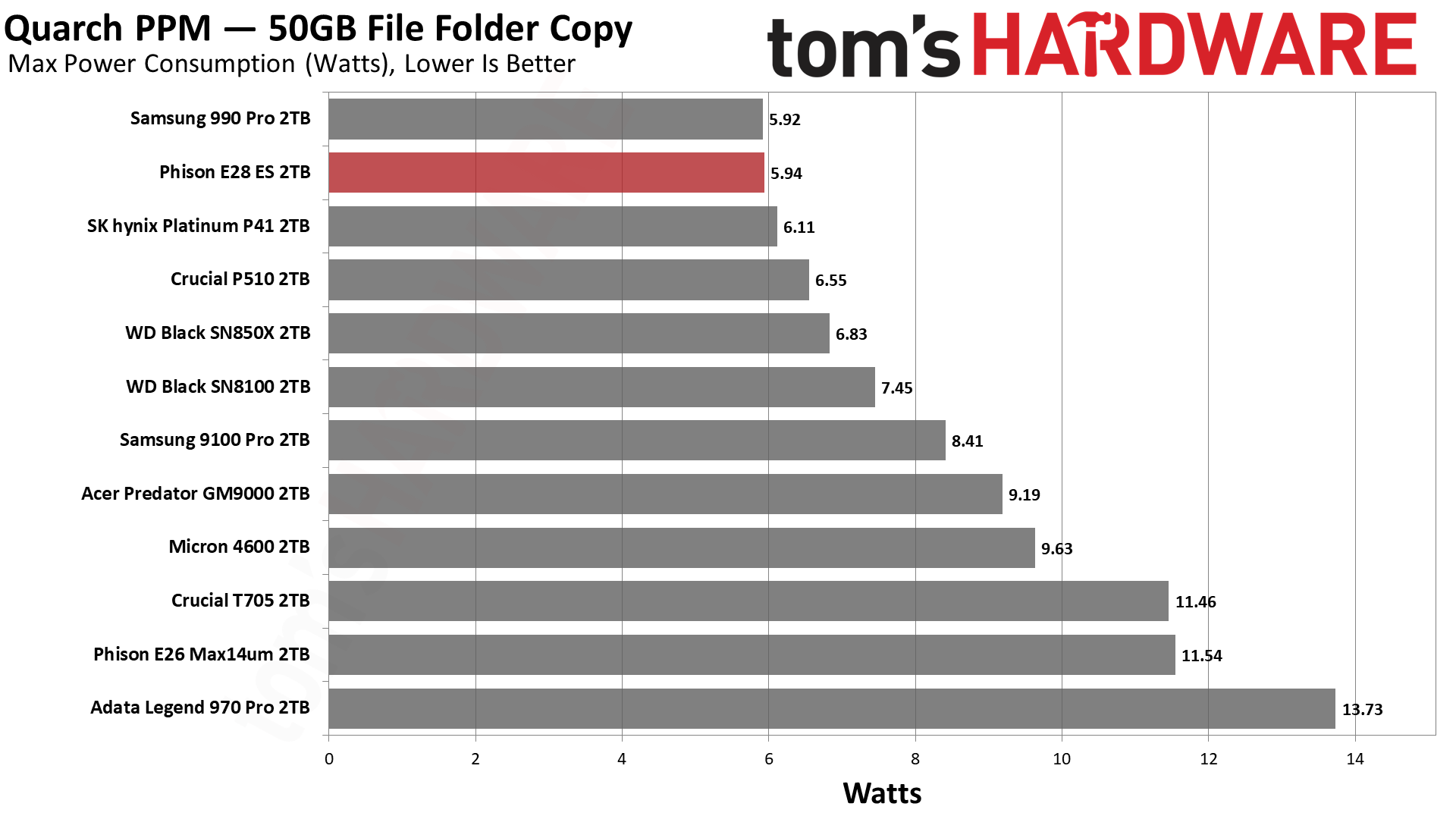

The E28’s biggest surprise is its record-setting power efficiency. We expected this drive to only be about as efficient as the WD Black SN8100, at best, but it easily outdid all of the competition. We certainly expected it to beat the SM2508-based drives that use Micron’s flash – the 4600 and GM9000 – but not by this much. Given that the E31T is in the 7nm node and that the SM2508 promised great power numbers quite a while ago, it’s likely that Phison targeted 6nm and power efficiency in particular when designing this SSD platform. This may be one reason it’s later to arrive, but if that’s the case, it’s well worth the wait. As a reminder, Phison also provides the PMIC or power management chip for its SSDs, which gives it some flexibility in improving efficiency.
The doubts about whether or not a high-end Gen 5 drive would be suitable for a laptop are gone. The E28 can operate without a heatsink in most environments and should be an excellent choice regardless of your application. Even if you only have a Gen 4 slot, this is a safe bet with some future proofing built in. Even in a desktop, we see solid improvements with the E28, as the dreaded high idle power usage of the E26 is now a thing of the past.
Test bench and testing notes
CPU | Row 0 - Cell 2 | |
Motherboard | Row 1 - Cell 2 | |
Memory | Row 2 - Cell 2 | |
Graphics | Intel Iris Xe UHD Graphics 770 | Row 3 - Cell 2 |
CPU Cooling | Row 4 - Cell 2 | |
Case | Row 5 - Cell 2 | |
Power Supply | Row 6 - Cell 2 | |
OS Storage | Row 7 - Cell 2 | |
Operating System | Row 8 - Cell 2 |
We use an Alder Lake platform with most background applications such as indexing, Windows updates, and anti-virus disabled in the OS to reduce run-to-run variability. Each SSD is prefilled to 50% capacity and tested as a secondary device. Unless noted, we use active cooling for all SSDs.
Phison E28 bottom line
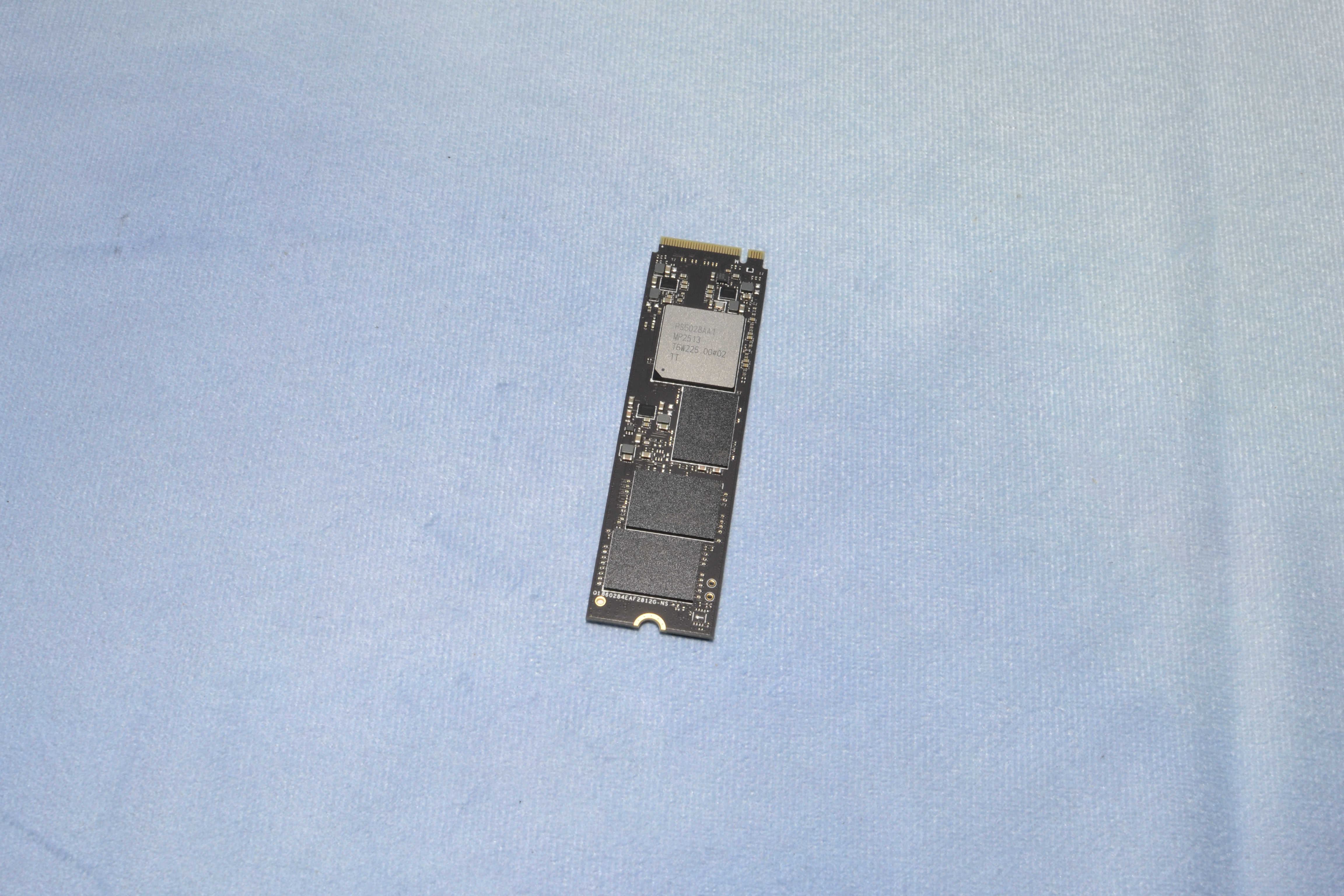
We just got done saying the WD Black SN8100 was one of the best drives we’ve ever tested and a candidate for a perfect score, only to have the Phison E28 engineering sample cross our desks. This is another fantastic drive that gets close to perfection with great all-around performance and downright amazing power efficiency. Only its relatively weak sustained write performance keeps it down, with other minor dips that we think can be ironed out with some firmware maturity. We’re also disappointed to see that 8TB drives may not be offered at launch, but we understand the limitation. The E28 is still an achievement in every way that matters.
We don’t think this is a drive for everyone, but if you’re looking for the combination of best performance and power efficiency, your search ends here. An E28-based SSD will work in just about any system for almost any application, and it’ll handle most things better than other drives on the market. The main caveat will likely be price, considering that Gen 4 drives are good enough for most people and will be significantly less expensive. This includes the WD Black SN850X, which remains the best choice for an 8TB solution.
The E28 clearly surpasses the E26 in power efficiency, which means the E28’s real competition will be anything built on the SM2508 – we’ve already reviewed the 4600, Predator GM9000, and WD Black SN8100, with the Crucial T710 on the way. We’ve found the SM2508 to be an excellent platform in its own right, but the E28 presents a compelling alternative. This should help drive relative prices down and yield more competition, which is always a good thing for consumers.
Having more choices with this level of performance and power efficiency is fantastic, especially as it will be a battleground for years to come. The E28 simply sets the new baseline by which others will be judged, and we look forward to testing optimized retail drives based on the platform in the coming months.
MORE: Best SSDs
MORE: Best External SSDs
MORE: Best SSD for the Steam Deck
- 1
- 2
Current page: Phison E28 2TB performance results
Prev Page Phison E28 2TB SSD Features and Specifications
Shane Downing is a Freelance Reviewer for Tom’s Hardware US, covering consumer storage hardware.
-
John Freiman So I'm going to assume that this drive as a dedicated SSD for a Plex Server and it's data hungry needs you fast random reads would make this a fabulous solution...Reply
The faster the server can load metadata for clients the better. Writes would be secondary since I don't believe they are time sensitive.
**All of this assumes that your transcode cache is going to a RAM disc.
I'm in! Sign my up for a 4TB and 8TB! -
Notton What is the reasoning behind disabling ASPM in Quarch Idle bench?Reply
Isn't that what gives extremely low power consumption while idle? -
JarredWaltonGPU Reply
For desktop use, ASPM isn't critical. It can reduce power use, but only by up to 1~2 watts in most cases (4W maybe on a "bad" drive with little to no power management), and it can create some slight additional latency at times. If you enable ASPM, in theory it just allows all SSDs to be put in a deep sleep state where they're waiting for the command to wake up, which means most will drop to ~50 mW of power use.Notton said:What is the reasoning behind disabling ASPM in Quarch Idle bench?
Isn't that what gives extremely low power consumption while idle?
By leaving ASPM off, we get to see the "still powered on while idle" power use, which is where an SSD will sit if it's getting periodic (like once every 5~60 seconds) accesses. In such a scenario, as I understand it, the SSD won't actually enter deep sleep states and thus continues to draw its idle power. On a desktop, this is still generally not a big deal, but in a laptop, if your SSD keeps getting accesses that limit the deep sleep time, it can end up drawing 1~2 watts of power for a few minutes before going back into deep sleep mode — repeated every time there's an SSD access. That can have a real-world impact on battery life.
On the Steam Deck, where I've previously done battery life testing with ASPM enabled (because AFAIK you can't disable it), basically every SSD ended up providing the "same" battery life because the drives would just enter deep sleep mode. Over time, changes to SteamOS improved battery life a bit, but without running a battery test that was actively using the SSD on occasion, everything looks identical. In practice, deep sleep modes will basically have the same end-user experience (even a 25 mW vs 100 mW difference just won't really matter, despite the latter being 4X higher), so looking more at the idle but not deep sleep power use makes sense.
In terms of power use, I'd consider efficiency the most important metric, then average power, then idle power, and finally the max power is only tangentially interesting (depending on how often a drive comes near that level). For laptops, idle power does become a bit more important, but the real consideration is how much power a drive needs on average while in active use, because that impacts cooling considerations. Drives that average over 5W of power when active can run very hot if placed in a laptop, and getting average power use to 4W or less is generally the goal.
